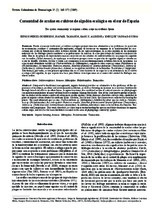Mostrar el registro sencillo del ítem
Comunidad de arañas en cultivos de algodón ecológico en el sur de España
| dc.contributor.author | Pérez-Guerrero, Sergio | |
| dc.contributor.author | Tamajón, Rafael | |
| dc.contributor.author | Aldebis, Hani K. | |
| dc.contributor.author | Vargas Osuna, E. | |
| dc.date.accessioned | 2013-05-03T07:48:49Z | |
| dc.date.available | 2013-05-03T07:48:49Z | |
| dc.date.issued | 2009 | |
| dc.identifier.uri | http://hdl.handle.net/10396/9936 | |
| dc.description.abstract | Frente al manejo tradicional, el cultivo ecológico proporciona una alternativa a los problemas de aparición de resistencias, residuos y contaminación ambiental, además de favorecer un aumento de la biodiversidad del ecosistema por el efecto beneficioso sobre la fauna auxiliar. En los agroecosistemas, la acción conjunta de los enemigos naturales de los fitófagos puede mantener a las poblaciones de muchos de ellos por debajo del umbral económico de daño. Uno de los grupos de depredadores menos conocidos en los estudios de control natural de las plagas del algodón son las arañas (Orden Araneae), de modo que se realizaron prospecciones en parcelas de algodón orgánico situadas en el sur de España: Córdoba, Sevilla y Cádiz. Los ejemplares se recolectaron mediante la batida directa de las plantas. La especie más abundante resultó ser Cheiracanthium sp. (Miturgidae), seguida de otras especies como Philodromus sp. (Philodromidae), los tomísidos Thomisus onustus, Runcinia grammica y Synema globosum (Thomisidae), Salticus sp. (Salticidae) y Larinia lineata (Araneidae). Además se recogieron individuos de las familias Theridiidae y Linyphiidae. Este trabajo, por tanto, es una primera aproximación en el conocimiento de las especies y su abundancia en el cultivo ecológico del algodón, lo que supone una base para futuras investigaciones en el marco del control de fitófagos mediante arañas. | es_ES |
| dc.description.abstract | Compared to traditional management, organic farming provides an alternative to the problems of the appearance of resistance, residues and environmental pollution, as well as favoring an increase in ecosystem biodiversity through beneficial effects on other fauna. In agroecosystems, the combined action of natural enemies on phytophages can maintain populations of many of them below economic damage thresholds. One of the least known groups of predators in studies on the natural control of cotton pests are the spiders (Order Araneae), therefore surveys were conducted in plots of organic cotton situated in southern Spain: Córdoba, Sevilla and Cádiz. Specimens were collected by beating the plants. The most abundant species was Cheiracanthium sp. (Miturgidae), followed by other species such as Philodromus sp. (Philodromidae), the crab spiders Thomisus onustus, Runcinia grammica and Synema globosum (Thomisidae), Salticus sp. (Salticidae) and Larinia lineata (Araneidae). In addition, individuals were collected from the families Theridiidae and Linyphiidae. This work, therefore, is a first step in understanding the species and their abundance in organic cotton crops, and will be the basis for future research in the area of phytophage control by spiders | es_ES |
| dc.format.mimetype | application/pdf | es_ES |
| dc.language.iso | spa | es_ES |
| dc.publisher | Sociedad Colombiana de Entomología | es_ES |
| dc.rights | https://creativecommons.org/licenses/by-nc-nd/4.0/ | es_ES |
| dc.source | Revista Colombiana de Entomología 35 (2), 168-172 (2009) | es_ES |
| dc.subject | Cultivo orgánico | es_ES |
| dc.subject | Organic farming | es_ES |
| dc.subject | Araneae | es_ES |
| dc.subject | Miturgidae | es_ES |
| dc.subject | Philodromidae | es_ES |
| dc.subject | Thomisidae | es_ES |
| dc.title | Comunidad de arañas en cultivos de algodón ecológico en el sur de España | es_ES |
| dc.title.alternative | The spider community in organic cotton crops in southern Spain | es_ES |
| dc.type | info:eu-repo/semantics/article | es_ES |
| dc.rights.accessRights | info:eu-repo/semantics/openAccess | es_ES |

